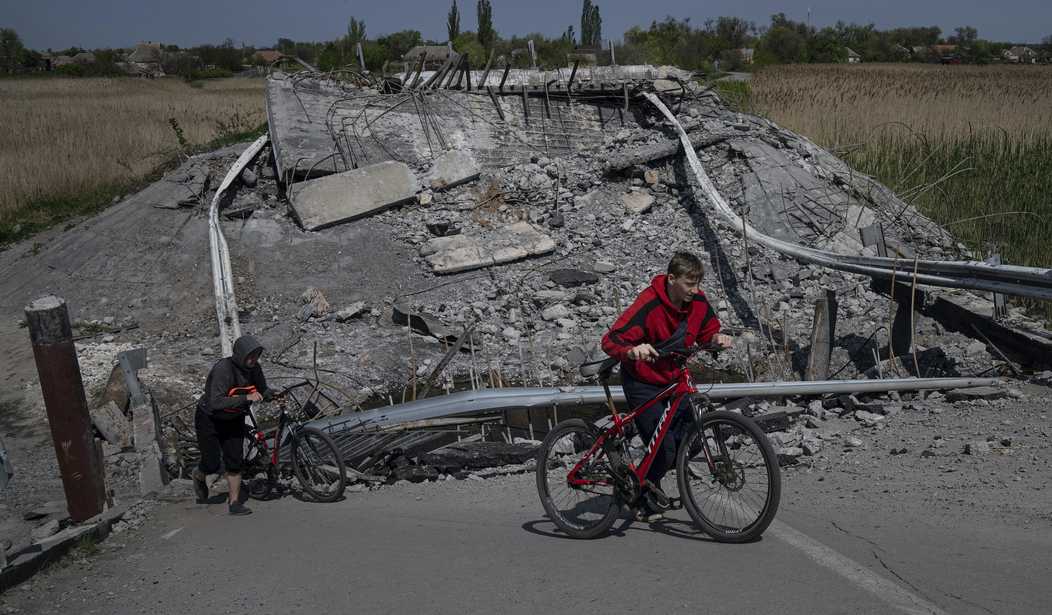Nearly no one today remembers firsthand what WW2 was. The youngest survivors are now in their late 90s. But the war in Ukraine has provided the younger generations a glimpse of what it must have been like. Although the technologies of the eras are vastly different, in human and dramatic terms, the narratives of both conflicts are strikingly similar. Through Ukraine, we can imagine what the Big One was like: national leaders fighting for their lives; battle maps with dramatic arrows drawn on them, each representing the lives of hundreds of men.
The full bitterness of defeat—just a video game term to many moderns—is conveyed in the shocked and tearful faces of displaced persons, fleeing collaborators, Russian television personalities, and desperate soldiers in retreat. It is the end of a world—all that was, with nothing to show for it but one’s survival, if that. The suddenness of it, how catastrophe can overtake all that was once regarded as permanent, gradually then all of a sudden, become evident to us.
The expense of it hits our inflation-haunted imaginations:
The war in Ukraine has proven that the age of industrial warfare is still here. The massive consumption of equipment, vehicles and ammunition requires a large-scale industrial base for resupply – quantity still has a quality of its own. The mass scale combat has pitted 250,000 Ukrainian soldiers, together with 450,000 recently mobilised citizen soldiers against about 200,000 Russian and separatist troops. The effort to arm, feed and supply these armies is a monumental task. … The rate of ammunition and equipment consumption in Ukraine can only be sustained by a large-scale industrial base.
Damage to whole towns and cities that were but a year before just like our own reminds us that there, but for the grace of God, go I.
Through Ukraine, onlookers from the Long Peace understand war, sort of, but at least better than before. The more astute realize that history is not over, and despite all the assurances of soft power, conflict may come again.
Perhaps most disturbingly for the Woke, none of the imperatives they value so much turned out to be much in demand in war. People proved far more interested in survival—in guns, power, water, firewood—than in climate change, social justice, or gender identity. Mobility depended on “fossil fuels,” and people scrounged for it. Where could anyone have charged an electric car in Ukraine anyway? Despite the reported death of the family as an institution, thousands risked or lost their lives searching for their parents, grandparents, children, and grandchildren. And when they met, there was no social distancing. They embraced. One of the small mercies of the war was that few were reputed to have died of Covid.
Videos on YouTube show amputees proposing to their sweethearts. And strangely, though perhaps not so surprising to students of history, both sides continue to fight on for that most discredited of motives: patriotism. For the ashes of their fathers and the temples of their gods. Against all odds, humanity and the nations survive. And while none of this may make sense to college-educated, ideological moderns, there it undeniably is. How to make sense of it? From somewhere in the backroom of the past, in the dim memory of a hundred-year-old man in a nursing home, comes the haunting melody that is the hint of an answer. “You must remember this. A kiss is just a kiss. A sigh is just a sigh. The fundamental things apply. As time goes by.”
Books: The Storm Before the Calm: America’s discord, the coming crisis of the 2020s, and the triumph beyond by George Friedman. Friedman’s analysis covers the size and scope of the federal government, the future of marriage and the social contract, shifts in corporate structures, and new cultural trends based on longer life expectancies. The result is a riveting account of current circumstances and the political upheavals that will pave the way for a new era of American prosperity and power.










Join the conversation as a VIP Member